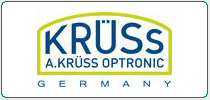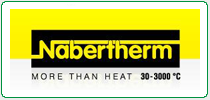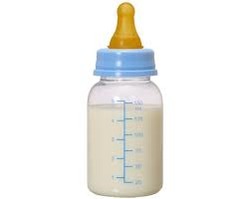
-
FriAM+07E_November+0700RNovAM+07_+07+07:0004
-
Created: 19 November 2021
USE
Provides a nutritional supplement for babies up to 12 months old.
TEST EQUIPMENT
Instrument: Powder Flow Tester (PFT)
Trough: 230 cc, 6-inch diameter
Lid Type: Vane Lid, 304 s/s, 33cc, 6-inch diameter (Flow Function)

-
ThuPM+07E_November+0700RNovPM+07_+07+07:0004
-
Created: 18 November 2021
TEST PRINCIPLE
To characterize and test the bulk density of powders to ensure accurate tablet manufacture. By defining the correct pressure to be used in a tablet making operation, that pressure can then be gauged by an accurate bulk density test.
BACKGROUND
A Brookfield Powder Flow Tester, equipped with Powder Flow Pro software for automated instrument control and data acquisition, is used to test powders for accurate bulk density measurements to ensure the correct pressures are being used in a tablet manufacturing process.

-
WedPM+07E_November+0700RNovPM+07_+07+07:0004
-
Created: 17 November 2021
Octane number is a measure of the knock resistance of gasoline. The higher the octane number, the lower knock resistance. Therefore, the gasoline with high octane number is marketed as a premium gasoline. Generally, 8-15% of fuel additives in the form of alcohol or ether are added to gasoline to increase the octane number.
Not like other additives such as olefins that can generate toxic pollutant like formaldehyde and acetaldehyde, oxygenates help pollutant like formaldehyde and acetaldehyde, oxygenates help fuel to burn more efficiently and reduce emission of air pollutants.

-
WedPM+07E_November+0700RNovPM+07_+07+07:0004
-
Created: 17 November 2021
BTEX (Benzene, Toluene, Ethylbenzene, o,m,p-Xylene) represents a group of volatile organic compounds (VOCs) and exists as gases at atmosphere pressure. Due to its water solubility, it’s classified as water contaminant and it’s also hazardous to health.
The recovery of VOCs analysis in water differs depending on sample preparation. Its high volatility decreases the recovery with LLE (Liquid/Liquid Extraction) or SPME (Solid Phase Micro Extraction).
-
WedPM+07E_November+0700RNovPM+07_+07+07:0004
-
Created: 17 November 2021
Analysis of Residual Solvents by ChroZen GC with Headspace

For pharmacopeial purposes, residual solvents in pharmaceuticals are defined as organic volatile chemicals that are used or produced in the manufacture of drug substances or excipients, or in the preparation of drug products. Because residual solvents have no therapeutic benefits but harmful effects to human body if they remain in the final products, it is required to regulate these compounds not to exceed the specific limits defined in certain regulations.
ChroZen GC/FID with ChroZen PAL RSI Headspace is the right system for analysis of residual solvents while providing the system suitability and reliability.
Contact us : This email address is being protected from spambots. You need JavaScript enabled to view it.
-
TuePM+07E_November+0700RNovPM+07_+07+07:0004
-
Created: 16 November 2021
Analysis of Natural Gas by ChroZen GC

Natural gases consist of methane (major component), other hydrocarbons and permanent gases like hydrogen, oxygen, nitrogen as well as carbon dioxide. They are used as major energy sources in numerous industries and it is very critical to accurately determine them because their value differs depending on chemical composition and the concentration of each component.
Among various analytical methods for natural gases, ASTM D1945 utilizes Gas Chromatograph (GC) configuring 5 columns and 3 detectors with 4 valves, which enables the analysis of complex natural gases in a single injection.
ChroZen GC with column switching valve system effectively analyzes natural gases by controlling the valve switching time with accuracy and precision and the gas flow can easily be modified depending on the gas composition.
ChroZen GC verifies the right solution for superior resolution and sensitivity of components in natural gases.
Contact us : This email address is being protected from spambots. You need JavaScript enabled to view it.
-
TueAM+07E_November+0700RNovAM+07_+07+07:0004
-
Created: 16 November 2021
COUGH SUPPRESSANT AND EXPECTORANT VISCOSITY MEASUREMENT APPLICATIONS
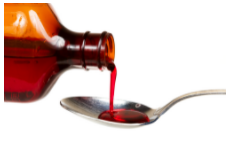
Use
To relieve coughs and chest congestion.
METHOD 1
Test Equipment
Instrument: Viscometer or Rheometer
Torque Range: RV
Spindle: YULA-15E
Accessories: Enhanced UL Adapter,
TC-550AP Programmable Bath
Speed: 50, 60, 70 ,80, 90, 100, 110, 120, 130, 140, 150, 160 and 170 RPM
Temperature: 22°C
Test Method
We used a Brookfield DV3TRV Rheometer with Rheocalc™ software for automated instrument control and data acquisition. The temperature was regulated using an ULA-EY water jacket connected to a TC-550AP Refrigerated Programmable Bath. We ran three trials to determine repeatability. A syringe was used to measure and dispense 16 mL of the substance into the sample chamber. The spindle and chamber were cleaned before each trial, and fresh material was used in each trial. We equilibrated the sample, spindle and chamber for at least three minutes prior to testing. We ran our test in a speed ramp fashion. Using traditional RV speeds like 50 and 100 RPM can make a sufficient test for this type of material. However, since we used a DV3T Rheometer, we had the capability of running the test at a wide variety of speeds. Representative data from the analyses are shown in Figure 1.
Figure 1 illustrates that both Brand A and Brand B are essentially Newtonian fluids. Newtonian fluids are characterized by a constant viscosity, independent of shear rate. Slight differences in viscosity over our range of shear rates can be accounted for by the 1% tolerance of the instrument. Figure 1 also shows that Brand A is more viscous than Brand B.

Figure 1: Viscosity vs. Shear Rate
METHOD 2
Test Equipment
Instrument: DV3T Rheometer
Torque Range: LV
Spindle: YULA-15E
Accessories: Enhanced UL Adapter, TC-550AP Programmable Bath
Speed: 3, 4, 5, 6, 7 ,8, 9, 10, 11, 12, 13, 14 and 15 RPM
Temperature: 22°C
Test Method
We used a Brookfield DV3TLV Rheometer with Rheocalc™ software for automated instrument control and data acquisition. The temperature was regulated using an ULA-EY water jacket connected to a TC-550AP Programmable Bath. We ran three trials to determine repeatability. A syringe was used to measure and dispense 16 mL of the substance into the sample chamber. The spindle and chamber were cleaned before each trial, and fresh material was used in each trial. We equilibrated the sample, spindle and chamber for at least three minutes prior to testing. We ran our test in a speed ramp fashion. Using traditional LV speeds like 3, 6 and 12 RPM can make a sufficient test for this type of material. However, since we used a DV3T Rheometer, we had the capability of running the test at a wide variety of speeds. Representative data from the analyses are shown in Figure 2.
Figure 2 illustrates that both Brand A and Brand B are essentially Newtonian fluids. Newtonian fluids are characterized by a constant viscosity, independent of shear rate. Slight differences in viscosity over our range of shear rates can be accounted for by the 1% tolerance of the instrument. Figure 2 also shows that Brand A is more viscous than Brand B.
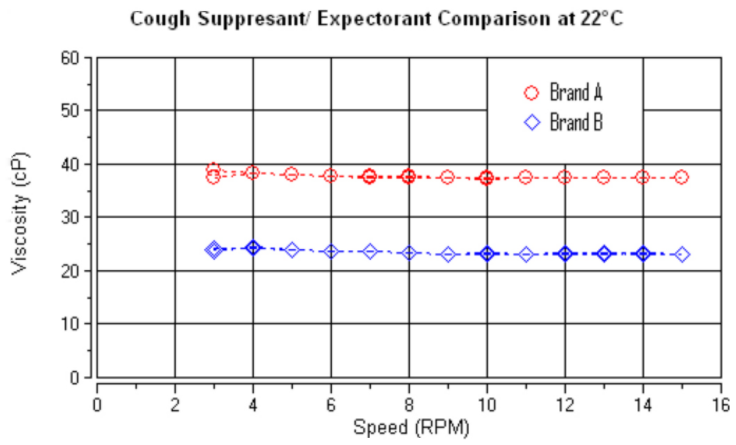
Figure 2: Viscosity vs. Rotational Speed
>>Download a pdf of this application note.
-
TueAM+07E_November+0700RNovAM+07_+07+07:0004
-
Created: 16 November 2021
BENTONITE CLAY VISCOSITY MEASUREMENT APPLICATIONS
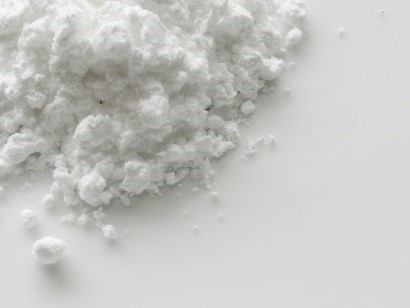 USE
USE
Bentonite Clay is a rheological “thickening” addictive for many products, such as paints and drilling muds.
TEST EQUIPMENT
Spring Torque: LV
Spindle: Helipath T-F
Speed: 5 RPM
TEST METHOD
The 10% by weight concentration of clay in solution was created with distilled water and tested. The mixture was tested within a 600 mL, low form, Griffin beaker at room temperature, about 23°C. A Helipath stand was used with the small T-F spindle because of the high viscosity and “pasty” nature of the sample. The Helipath tests “fresh” material as it rotates the T-bar spindle moving downward into the sample. This may be a big advantage when testing materials whose structure breaks down and take significant time to rebuild.
Rheocalc software controlled the Brookfield DV2T Viscometer. Data from this test is shown in Figure 1.
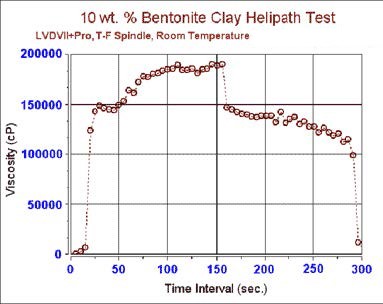
Figure 1
The spindle “drills” down into the sample from 0 to 156 seconds. There is a noticeable decrease in viscosity after 156 seconds, when the spindle reverses direction and works its way back up through previously tested clay. One noticeable aspect of the graph is that it shows the stratification of the clay mixture. From 25 to 50 seconds the viscosity remains fairly constant, and then it gradually increases as the spindle descends.
>>Download a pdf of this application note.
Contact us : This email address is being protected from spambots. You need JavaScript enabled to view it.
-
MonPM+07E_November+0700RNovPM+07_+07+07:0004
-
Created: 15 November 2021
Auto Paint - ASTM D7395 VISCOSITY MEASUREMENT APPLICATIONS
 USE
USE
To coat automobile exteriors, making their appearance more attractive.
TEST EQUIPMENT
Viscometer: High Torque CAP 2000+L
and Low Torque 2000+L
Spindle: Cone 10 (CAP-S-10)
Speed: 100 RPM
Temperature: 25°C
TEST METHOD
In our experiment we used the “Standard Test Method for Cone/Plate Viscosity at a 500 s-1 Shear Rate” as described in ASTM Standard D7395. This test method for measuring paint viscosity calls for the material to be equilibrated at 25°C for one minute. The test method recommends using the solvent trap to help prevent evaporation of the material.
We used a High Torque CAP 2000+L and a Low Torque CAP 2000+L viscometer with Capcalc software for automated instrument control and data acquisition. We used Cone 10 to achieve on-scale results with 170 μL of fluid. The cone and plate were cleaned before dispensing each paint portion. A fresh portion of sample was used for each trial. Three trials were done for each color of paint. Representative data from the analyses are shown in Figures 1, 2, and 3.
The tolerance for the High Torque CAP 2000+L Viscometer running at 100 RPM with cone 10 is +/-100 cP, for the Low Torque CAP 2000+L Viscometer is +/-4.4 cP. Figures 1 and 2 show that results obtained with the Low Torque CAP 2000+L and the High Torque CAP 2000+L Viscometer were repeatable within the tolerance of the viscometers.
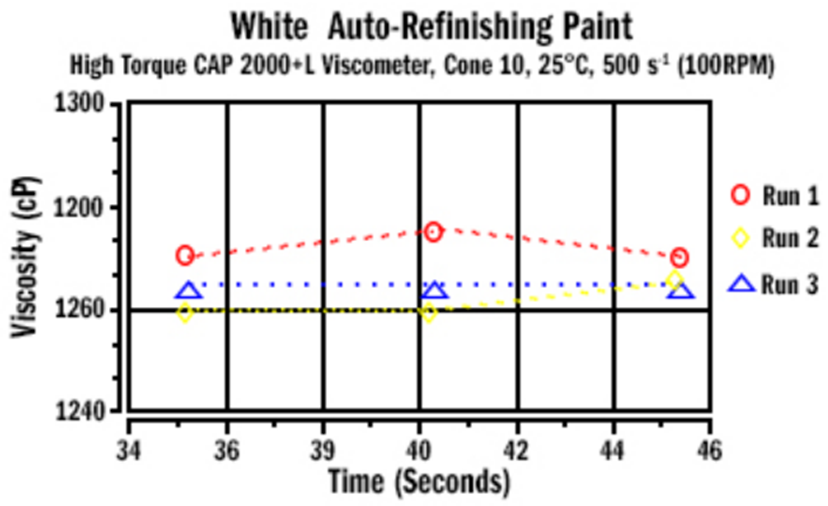
Figure 1
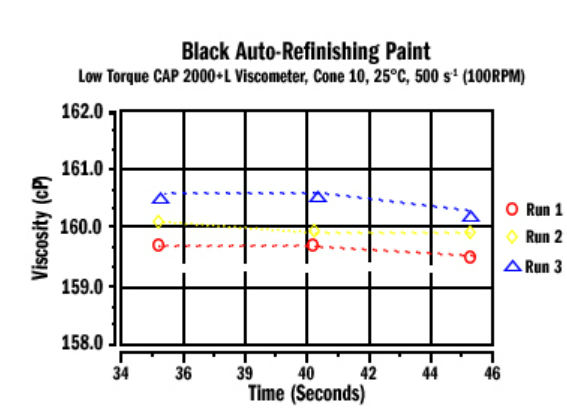
Figure 2
Figure 3 plots Run 1 of Figures 1 and 2. Figure 3 shows the great difference in the viscosities of Black and White Auto- Refinishing Paints. This difference required different viscometers to be used for each paint. For the black paint, we used a Low Torque CAP 2000+L Viscometer so we could achieve on scale results at a lower viscosity. For the white paint, we used a High Torque CAP 2000+L Viscometer so we could achieve on scale results at a higher viscosity.
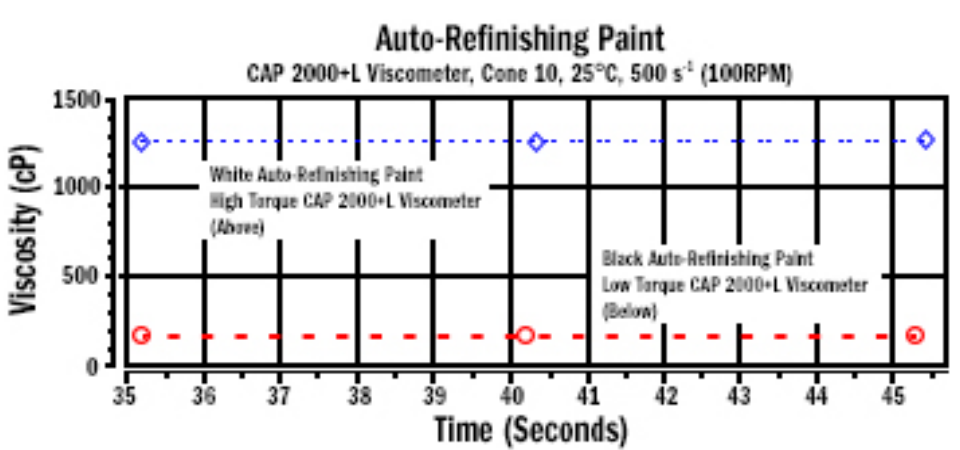
Figure 3: Test Method Comparison: Black and White Auto-Refinishing Paint
>>Download a pdf of this application note
Contact us : This email address is being protected from spambots. You need JavaScript enabled to view it.
-
MonPM+07E_November+0700RNovPM+07_+07+07:0004
-
Created: 15 November 2021
Auto Paint - ASTM D4287 VISCOSITY MEASUREMENT APPLICATIONS
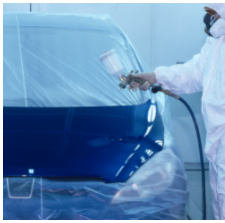 USE
USE
To coat automobile exteriors, making their appearance more attractive.
TEST EQUIPMENT
|
Viscometer: |
High Torque CAP 2000+L |
|
Spindle: |
Cone 01 (CAP-S-01) |
|
Speed: |
750 and 900 RPM |
|
Temperature: |
25°C |
TEST METHOD
Paint is tested at high shear rates (10,000 -12,000 s-1), to simulate the flow behavior that paints undergo while being sprayed. The test methods that we used were based upon the standard test methods set forth by ASTM D4287 (common standard in North America) which is run at 12,000 s-1, and the standard test methods set forth by ISO2884 and BS3900 (common standards in Europe), which are run at 10,000 s-1.
We used a High Torque CAP 2000+L viscometer, with Capcalc software for automated instrument control and data acquisition. We used Cone 01 to achieve on-scale results with 67 μL of fluid sample. The cone and plate were cleaned before dispensing each paint portion. A fresh portion of sample was used for each trial. Three trials were done for each speed. We equilibrated the sample and cone at 25°C for 30 seconds prior to testing. The solvent trap was used to help prevent evaporation. Representative data from the analyses are shown in Figures 1, 2, and 3.
Figure 1 shows the data obtained by the standard test method described by ISO 2884 more commonly used in Europe.
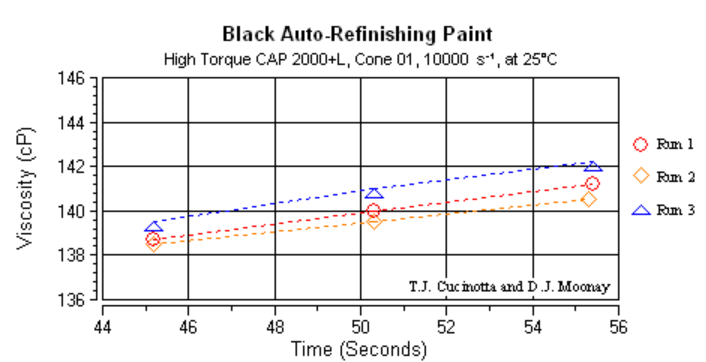
Figure 1: Standard ISO 2884 Test Method
Figure 2 shows the data obtained by the standard test method described by ASTM D4287 more commonly used in North America.
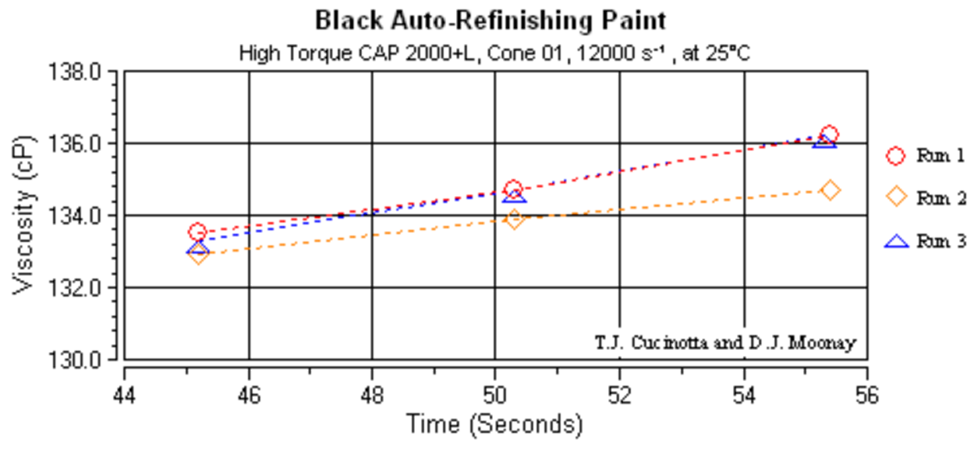
Figure 2: Standard D4287 Test Method
Figure 3 plots Run 1 of Figures 1 and 2.
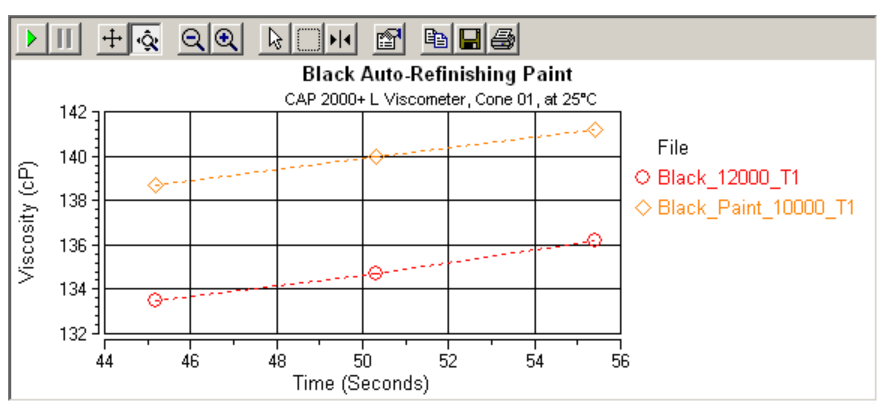
>>Download a pdf of this application note.
Contact us : This email address is being protected from spambots. You need JavaScript enabled to view it.








